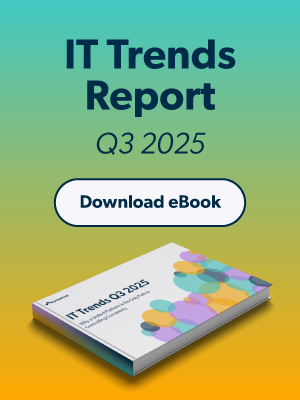Updated on May 21, 2025
Securing data in transit is crucial. Without proper protection, it can be intercepted, altered, or accessed without permission, leading to serious privacy and security issues. This article covers the basics, risks, and key methods for protecting data in transit.
Definition and Core Concepts
Data in transit, sometimes called “data in motion,” refers to any digital information moving through a network from one endpoint to another. This may include communication between:
- Client and server: Such as accessing websites or applications.
- Network nodes: Like routers, switches, or data centers.
- Devices and systems: For example, sending an email or streaming media.
How Data in Transit Differs from Other Data States
- Data at rest is stored information waiting for access—such as files saved on a server or database.
- Data in use is actively being processed by an application or system, like in-memory computation.
Common Use Cases
Data in transit is omnipresent in modern communication scenarios, including:
- Email transmission using protocols like SMTP.
- File transfers via SFTP or file-sharing platforms.
- Video conferences or real-time messaging.
How Data in Transit Works
To understand how data traverses networks, consider the following components:
The Journey of Data
- Origination: Data packets are created when a user initiates communication, such as logging into a website or sending a message.
- Transport Layers: Protocols like Transmission Control Protocol/Internet Protocol (TCP/IP) break the data into manageable packets. TCP ensures the packets arrive intact and in order, while IP routes the packets to their destination.
- Routing: Network devices like routers and switches forward packets along the optimal path toward the receiving endpoint.
Key Protocols at Play
- Transport Layer Security (TLS) protects data integrity during transmission by encrypting it.
- Hypertext Transfer Protocol Secure (HTTPS) secures web communication through encrypted connections.
- Virtual Private Networks (VPNs) encapsulate and encrypt data for secure transit over public networks.
Intermediaries and Their Role
Intermediary devices like routers, switches, and proxies not only direct data traffic but also provide opportunities for attackers if mishandled. A properly maintained network is essential to safeguard these transition points.
Security Risks Associated With Data in Transit
Although data in transit enables the smooth functioning of digital operations, it is vulnerable to multiple threats without proper safeguards. Here are some common risks:
Eavesdropping
Attackers may intercept unencrypted data, such as login credentials or sensitive company files, by “listening in” on network traffic.
Man-in-the-Middle (MITM) Attacks
Cybercriminals position themselves between two communicating parties, making it appear as though legitimate communication is occurring while they alter or steal sensitive information.
Packet Sniffing
Malicious actors can use packet-sniffing tools to analyze and capture network traffic, exposing credit card details, personal data, or authentication tokens.
Public Wi-Fi Vulnerabilities
Using unsecured public Wi-Fi makes data in transit particularly susceptible to interception, as attackers can easily exploit open networks.
Methods to Secure Data in Transit
To mitigate security risks, organizations can implement various safeguards. Below are widely adopted practices to secure data in transit effectively:
Encryption
Encryption encodes data, making it indecipherable without a decryption key. Key encryption protocols include:
- TLS/SSL: Ensures secure connections for emails, web traffic, and APIs.
- IPSec: Encrypts IP packets for secure communication.
Virtual Private Networks (VPNs)
VPNs mask private data by encrypting all transmitted traffic and routing it through a secure server, especially vital for employees working remotely.
Secure Communication Channels
Employ secure protocols such as:
- HTTPS for browsing.
- SFTP for file transfers.
- End-to-end encryption (E2EE) for messaging apps (e.g., Signal and WhatsApp).
Use of Digital Certificates
Public Key Infrastructure (PKI) and digital certificates authenticate servers and enable secure client-server communication. Tools like mutual authentication further prevent unauthorized access.
Regular Security Assessments
Routine assessments and penetration testing of enterprise networks ensure that vulnerabilities related to data in transit are identified and addressed proactively.
Use Cases and Real-World Applications
Understanding the utility of secure data in transit enables organizations to implement protective measures effectively. Here are notable use cases across industries:
Secure Email Communication
Organizations often employ PGP (Pretty Good Privacy) encryption to protect email exchanges containing sensitive data.
Safe Browsing with HTTPS
Web applications and online stores secure their users’ data—including passwords and payment details—with HTTPS.
Encrypted Voice and Video Calls
End-to-end encryption ensures secure communication within collaboration tools.
Enterprise-Level VPNs for Remote Workforce
Companies employing remote work establish VPNs to ensure secure data transmission between employees and centralized systems.
Glossary of Terms
- Data in Transit: Information actively traveling from one location to another over a network.
- Encryption: The process of encoding information into a secure format to prevent unauthorized access.
- HTTPS (Hypertext Transfer Protocol Secure): An encrypted protocol for secure communication between browsers and websites.
- TLS (Transport Layer Security): A cryptographic protocol ensuring confidentiality and integrity for data in transit.
- Man-in-the-Middle Attack: A cyberattack where a hacker intercepts and potentially modifies communications between two parties.
- VPN (Virtual Private Network): A tool encrypting internet traffic and masking IP addresses for secure online activity.
- Digital Certificates: Credentials used to authenticate identities and enable encrypted communication.






